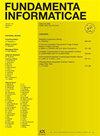基于双域DNA链位移的互补体逻辑运算模型
IF 0.4
4区 计算机科学
Q4 COMPUTER SCIENCE, SOFTWARE ENGINEERING
引用次数: 1
摘要
DNA链置换技术具有操作简单的优点,成为DNA计算的常用方法。本文提出了一种基于双结构域DNA链置换的四位二进制数补码器。它实现了将二进制代码转换为补码的功能。基于Visual DSD软件进行了仿真实验。仿真结果表明了补码逻辑模型的正确性和可行性,为进一步拓展分子逻辑电路的应用提供了有益的探索。本文章由计算机程序翻译,如有差异,请以英文原文为准。
Logic Operation Model of the Complementer Based on Two-domain DNA Strand Displacement
DNA strand replacement technology has the advantages of simple operation which makes it becomes a common method of DNA computing. A four bit binary number Complementer based on two-domain DNA strand displacement is proposed in this paper. It implements the function of converting binary code into complement code. Simulation experiment based on Visual DSD software is carried out. The simulation results show the correctness and feasibility of the logic model of the Complementer, and it makes useful exploration for further expanding the application of molecular logic circuit.
求助全文
通过发布文献求助,成功后即可免费获取论文全文。
去求助
来源期刊

Fundamenta Informaticae
工程技术-计算机:软件工程
CiteScore
2.00
自引率
0.00%
发文量
61
审稿时长
9.8 months
期刊介绍:
Fundamenta Informaticae is an international journal publishing original research results in all areas of theoretical computer science. Papers are encouraged contributing:
solutions by mathematical methods of problems emerging in computer science
solutions of mathematical problems inspired by computer science.
Topics of interest include (but are not restricted to):
theory of computing,
complexity theory,
algorithms and data structures,
computational aspects of combinatorics and graph theory,
programming language theory,
theoretical aspects of programming languages,
computer-aided verification,
computer science logic,
database theory,
logic programming,
automated deduction,
formal languages and automata theory,
concurrency and distributed computing,
cryptography and security,
theoretical issues in artificial intelligence,
machine learning,
pattern recognition,
algorithmic game theory,
bioinformatics and computational biology,
quantum computing,
probabilistic methods,
algebraic and categorical methods.
 求助内容:
求助内容: 应助结果提醒方式:
应助结果提醒方式:


